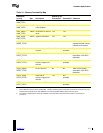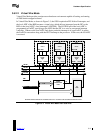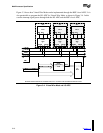
MultiProcessor Specification
3-6 Version 1.4
Table 3-2. APIC Versions
APIC Type
Local APIC Version
Register (hexadecimal) Integrated APIC Features
82489DX APIC 0x
Integrated APIC, i.e.,
Pentium processors (735\90,
815\100)
1x STARTUP IPI. See Appendix B.4.2 for details.
Programmable interrupt input polarity
NOTE:
x
is a 4-bit hexadecimal number.
To encourage future extendibility and innovation, the Intel APIC architecture definition is limited
to the programming interface of the APIC units. The ICC bus protocol and electrical specifications
are considered implementation-specific. That is, while different versions of APIC implementations
may execute the same binary software, different versions of APIC components may be
implemented with different bus protocols or electrical specifications. Care must be taken when
using different versions of the APIC in a system.
The APIC architecture is designed to be scaleable. The 82489DX APIC has an 8-bit ID register
that can address from one to 255 APIC devices. Furthermore, the Logical Destination register for
the 82489DX APIC supports 32 bits, which can address up to 32 devices. For small system
implementations, the APIC ID register can be reduced to the least significant 4 bits and the Logical
Destination register can be reduced to the most significant 8 bits.
To ensure software compatibility with all versions of APIC implementations, software developers
must follow the following programming guidelines:
1. Assign an 8-bit APIC ID starting from zero.
2. Assign logical destinations starting from the most significant byte of the 32-bit register.
3. Program the APIC spurious vector to hexadecimal “xF,” where x is a 4-bit hexadecimal
number.
The following features are only available in the integrated APIC:
1. The I/O APIC interrupt input signal polarity can be programmable.
2. A new interprocessor interrupt, STARTUP IPI is defined.
In general, the operating system must use the STARTUP IPI to wake up application processors in
systems with integrated APICs, but must use INIT IPI in systems with the 82489DX APIC. Refer
to Appendix B, Section B.4, for application processor startup.
3.6.2 Interrupt Modes
The MP specification defines three different interrupt modes as follows:
1. PIC Mode—effectively bypasses all APIC components and forces the system to operate in
single-processor mode.
2. Virtual Wire Mode—uses an APIC as a virtual wire, but otherwise operates the same as PIC
Mode.
3. Symmetric I/O Mode—enables the system to operate with more than one processor.


















